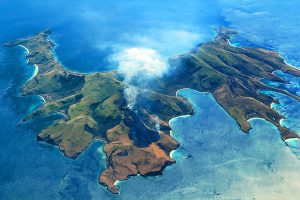In March, Indonesia’s Ministry of Fisheries and Marine Affairs issued Ministerial Decision No. 14/2021 on the Flow of Pipelines and Submarine Cables Policy. The regulation updated the technical guidance for the organization of pipelines and submarine cables, indicating that Indonesia is steadily moving to improve underwater infrastructure management.
The decision clarified the arrangement of 217 corridors for submarine cables and pipelines, 209 beach manholes, and the four national landing stations in Batam (Riau Islands province), Kupang (East Nusa Tenggara province), Manado (North Sulawesi province), and Jayapura (Papua province), as well as the 186 submarine cables installed outside the existing corridors. It stated that pipelines and submarine cables must be reviewed every five years or as required to account for changing environmental conditions and natural disasters.
This submarine cable network constitutes the vital connecting tissue for electronic communications between far-flung parts of the vast Indonesian archipelago. One program currently being pursued by the Ministry of Information and Communication is the construction of the East Palapa Ring, which will connect the eastern Indonesian islands to the rest of the country. This will involve the placement of 4,450 kilometers of submarine cables, including 3,850 kilometers of fiber-optic cables. As this suggests, Indonesia’s telecommunications infrastructure is tightly intertwined with its management of the maritime domain.
Moreover, the submarine cable network is key to President Joko Widodo’s efforts to support Indonesia’s digital economy and industry. In April 2021, Minister of Industry Agus Gumiwang Kartasasmita announced the “Making Indonesia 4.0” roadmap during the Hannover Messe Expo, highlighting the country’s intention to promote its technological strength and connectivity. Digital transformation must be underpinned by a sophisticated network of submarine cables, as they play an important role in facilitating data transfer, internet access, and cloud storage. Even at the global level, 95 percent of data traffic is enabled by submarine fiber-optic cables.
Nonetheless, the security of Indonesia’s submarine cable communication system has been compromised on multiple occasions, a result of both natural disasters and human error. This can have devastating consequences for electronic communication. In May 2021, the submarine cable network carrying data traffic to Jayapura, the capital of Papua province, was severed, supposedly due to natural causes. This led to more than 500,000 people living in the province’s four regions losing internet access. The operator PT Telkom Indonesia attempted to restore the telecommunication access for telephones and SMS as well as minimum internet access for the provincial government and local hospitals as quickly as possible.
Other threats to submarine cables originate from the unintended effects of maritime activities, such as the use of fish aggregating devices (FADs), anchor dropping, sand mining, and cable theft along the submarine cable communication system. According to the Association of Sea Cable Communication Systems, 47 percent of disruptions are caused by anchor dropping, 28 percent by fishing with FADs, 14 percent by natural causes, and 11 percent by sand mining and cable theft. In Indonesia, too, anchor dropping is the greatest threat to the submarine cable communication system by far, given that submarine cables are installed along the Indonesian Archipelagic Sea Lanes frequently used by ships.
One of the most serious cases of breakage occurred in June 2018 near the waters of Riau Islands province, when a Singapore-flagged vessel unintentionally broke the submarine cable owned by Indonesia’s largest telecommunication provider PT Triasmita after dropping its anchor. With the province’s waters hosting a multitude of submarine cable communication systems as well as the crowded international shipping routes from both the Malacca Straits and the South China Sea, such accidents are hard to avoid.
Meanwhile, the management of the submarine cable network is fragmented because of government functions being vested in various government institutions, and the lack of a nationally coordinated policy. For instance, the Ministry of Marine Affairs and Fisheries has released Ministry Regulation No. 26/2014 regulating the use of FADs but it does not prohibit their use near submarine cables. Moreover, the prevention and handling of submarine cable incidents are not specifically regulated by government agencies. Ad hoc cooperation is carried out under an MoU between PT Triasmita, Indonesia’s largest provider of telecommunication services, and the Maritime Security Agency (Badan Keamanan Laut, or Bakamla). With limited resources and patrol ships, Bakamla is ill-equipped to prevent such incidents. In some cases, PT Triasmita has to resort to deploying its own patrol boats around submarine cable areas.
In the absence of a comprehensive security mechanism to protect Indonesia’s critical underwater infrastructure, the government needs to take action to enhance and reinforce the recently issued policy on the arrangement of submarine cables. At a broader level, there is a need to increase Indonesia’s Underwater Domain Awareness (UDA) by enhancing sensing, analyzing, and regulating capabilities. By tasking the Indonesian Navy’s Hydrography and Oceanography Center with leading the technical team for submarine cable system rearrangement, the government has made the right call to map out the underwater geophysical landscape to understand the potential threats to the submarine cable system.
Improving the capabilities of Indonesia’s security agencies to monitor the landing areas and the submarine cable communication corridors is crucial. In this context, it is necessary for Bakamla to increase the number of fast patrol boats able to monitor fishing and cargo vessels anchored in the vicinity of the submarine cable communication system corridors.

































